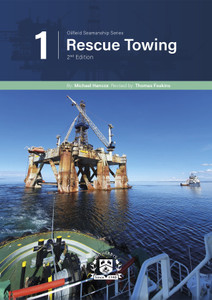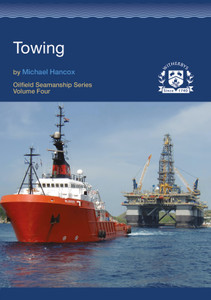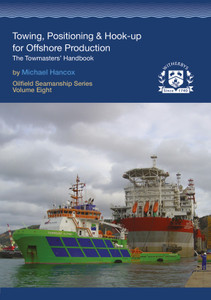
This volume of the Oilfield Seamanship Series illustrates how jackup rigs are safely moved from one location to another in an offshore environment. The purpose of the book is to support tow Masters, personnel responsible for moving jackup rigs, tug and anchoring handling vessel crews, and those ashore involved in planning rig move operations.
This
second
edition
reflects
significant
changes
to
the
ways
in
which
jackups
are
managed
when
afloat,
such
as
those
concerning
design
rules,
regulations,
guidelines
and
codes
of
practice.
It
includes
changes
to
jackup
moving
operations,
which
are
now
conducted
under
a
detailed
and
agreed
Rig
Move
Procedure
(RMP).
This
document
clearly
sets
out
the
duties
and
responsibilities
of
the
principal
parties
involved,
the
criteria
to
be
used
when
making
decisions
regarding
starting
and
stopping
operations
and
the
details
of
any
sea
passage
to
be
undertaken.
The
book
is
appended
with
pre-move
checklists
and
verified
tow
Master
calculations.
This
edition
has
been
updated
to
include
intricate
technical
illustrations,
which
have
been
annotated
to
reflect
the
steps
involved
in
complex
positioning
operations.
Factors
such
as
weather
criteria,
seabed
analysis
and
Certificate
of
Approval
acquisition
have
also
been
included,
making
this
a
both
a
comprehensive
and
practical
reference
tool.
This volume of the Oilfield Seamanship Series illustrates how jackup rigs are safely moved from one location to another in an offshore environment. The purpose of the book is to support tow Masters, personnel responsible for moving jackup rigs, tug and anchoring handling vessel crews, and those ashore involved in planning rig move operations.
Tow Masters moving jackup rigs should have relevant experience of working on tugs or as barge engineers. Barge engineers are familiar with jacking gear, preloading requirements, maintenance of jacking equipment and issues associated with rack phase differences (RPDs). Tow Masters with experience on vessels have a good understanding of towing wires and ropes, tow angles, bollard pull (BP) requirements and weather criteria. The subjects covered in this publication will complement the existing knowledge of tow Masters who want to expand their understanding of particular jacking or vessel operations.
Jackup rig crews are familiar with their own operations, ie drilling, but if not experienced in moving rigs, they must be well briefed in afloat operations by the tow Master on board. This ensures that all personnel are aware of the risks associated with the marine environment and potential poor weather.
In 2022 there are over 500 jackup rigs in worldwide operation, compared to 205 semi-submersibles1. Despite advances in technology such as remote RPD measurements, more stringent Class build requirements and warranty requirements on towing, there continue to be incidents where jackup rigs are damaged, or indeed lost, such as the ‘Naga 7’ in 2021. A better understanding of the operational aspects of jackup rig moving will assist in all parties’ appreciation of potential hazards when moving from one location to the next, and what can be done to safely mitigate those hazards.
The work contained within this publication was carried out with the assistance of the original author Captain Michael Hancox and Captains Hans Villadsen, Rob Breure and Josh Develing.
Thomas Feakins, 2022
Foreword vii
Introduction ix
Notes on Units of Measurement xi
1. Jackup Rigs
1.1 Moving Jackups
1.2 Rig Types in Operation
1.3 Structure of Rigs
1.4 Towing Arrangements On Board
1.5 Anchors
1.6 Positioning System Equipment
1.7 Survey Equipment
1.8 Correction and Misalignment – Elevated Operations
1.9 Location onto Subsea Templates/Wellheads – Wire Method
1.10 Marine Operations Manual
2. Tugs and Equipment
2.1 Overview of Tugs
2.2 Tugs
2.3 Anchor Handling Tugs
2.4 Small Seagoing Tugs/Multipurpose Tugs
2.5 Harbour Tugs
2.6 Towing Wires, Ropes, Pennants and Other Equipment
2.7 Tow Master’s Equipment
2.8 Towing Power Calculations
3. Jackup Move Plan and Process
3.1 Initial Stages
3.2 Outline of Jackup Rig Move Procedure (RMP)
3.3 Shoreside Hazard Identification and Risk Assessment (HIRA)
3.4 Pre-move Operations
3.5 Criteria for Towing
4. Emergency and Contingency Plans
4.1 Overview
4.2 Class Requirements
4.3 Emergency Plans
4.4 Contingency Plans
5. Jacking Down, Freeing Legs and Getting Afloat
5.1 Hazards Associated with Jacking Down and Getting Afloat
5.2 Jacking Down
5.3 Freeing Legs
5.4 Freeing Deeply Penetrated Legs
5.5 Connection of Tugs
5.6 Working in Areas of High Tidal Range
6. Towage
6.1 Hazards Associated with Towing Off Location
6.2 Manoeuvring with Tugs
6.3 Towage During Sea Passages
6.4 Passage Considerations
6.5 Passage Interfield – Short Distances
6.6 Port Towage
7. Float On/Off Heavy Lift Vessels (HLVs)
7.1 Hazards Associated with Floating On and Off an HLV
7.2 Use of Tugs
7.3 Use of HLV Lines
7.4 Responsibilities
7.5 Stability and Ballasting Operations
7.6 HLV Sea Fastenings
7.7 Securing Rigs for Barge or HLV Tows
8. Approach to Standoff Location
8.1 Hazards When Approaching Standoff Location
8.2 Picking up Towlines
8.3 Lowering Legs
8.4 Calculations for Standoff Location
8.5 Wavelength and Jacking
9. Jacking Gear and Jacking Operations
9.1 Overview of Jacking Gear
9.2 Precautions with Jacking Gear
9.3 Common Issues with Jacking Gear
9.4 Sequence of Jacking Operations
9.5 Decision Making Process – Jacking Criteria
9.6 Example for Checking Torque on Jacking Motors
10. Running Anchors
10.1 Hazards Associated with Running Anchors
10.2 Mooring Arrangements
10.3 Midline Buoy Procedures
10.4 Anchors
10.5 Winches and Mooring Wires
10.6 AHTS Setup for Working Anchors
11. Positioning at Location
11.1 Hazards Associated with Positioning
11.2 Open Location – Tug Deployment
11.3 Use of Stern Bridle
11.4 Tug Operations
11.5 Transit Between Standoff and Final Position
11.6 Positioning onto a Platform – Basic Method
11.7 Positioning onto a Platform – Complex Method
11.8 Walking onto a Final Position
11.9 Winch Operations
12. Preloading Operations
12.1 Hazards Associated with Preloading Operations
12.2 Procedures for Preloading
12.3 Monitoring of the Rig During Preloading Operations
12.4 Preloading – One Leg at a Time
12.5 Punch Throughs and Rapid Penetrations
12.6 Preloading Four-legged Jackups
12.7 Hydraulic Preloading
12.8 Preloading in Areas of High Tidal Range
12.9 Leg Footing Strength – Hard Seabeds
13. Rack Phase Differences (RPDs)
13.1 Overview 16913.2 Causes of RPDs
13.3 Existing Spudcan Holes
13.4 Repositioning a Jackup to Avoid RPDs
13.5 Measuring RPDs
13.6 Preventing RPDs from Causing Damage
13.7 Practical Solutions to RPDs
13.8 Leg Foundation Stability
13.9 Scour Considerations
14. Marine Warranty Surveyor
14.1 Overview
14.2 Certificate of Approval (CofA)
14.3 Weather Criteria
14.4 Site Investigation Hazards and Evaluation
15. Stability
15.1 Jackup Rig Stability
15.2 Calculating Leg Reactions
15.3 Motion Limits – Diagrams and their Use
15.4 Critical Motion Curves
15.5 Tug Stability
Appendices
Appendix 1: Calculating Leg Reactions
Appendix 2: Tow Master’s Approximate Calculations
Appendix 3: Selecting Tugs for Jackup Operations
Appendix 4: Pre-move Checklist
Appendix 4A: Tow Master (in conjunction with the OIM/barge Master)
Appendix 4B: OIM/barge Master (in conjunction with tow Master and rig Superintendent/Senior Toolpusher)
Appendix 4C: Barge engineer
Appendix 5: Daily Afloat Operations Checklist
Appendix 6: Rig Move Checklist
Appendix 7: Tow Master Checklist
Appendix 8: Soil Classification Table
Glossary of Terms
References
Practical Exercises
Witherby Publishing Group
Witherbys titles are developed using scripts developed by technical experts that are peer reviewed within work groups. Typically, they seek to improve understanding of the regulations, recommendations and guidelines issued by Industry.
Witherbys staff have significant expertise in the fields of navigation and hazardous cargoes as well as in the presentation of complex subjects in a graphic and easy to understand manner.
- Number of Pages:
- 243
- ISBN:
- 9781914992896
- Published Date:
- January 2023
- Book Height:
- 297 mm
- Book Width:
- 210 mm
- Weight:
- 1.2 kg
- Author:
Michael Hancox, Revised by Thomas Feakins
- Preview:
- Yes
- Publication Date:
- January 2023






